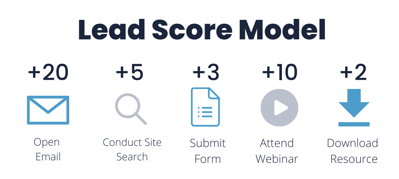If you've implemented any type of marketing automation, the topic of “lead scoring” has either come up or is going to come up sometime. What is lead scoring? How does lead scoring work?
When it comes to working through a marketing and sales process, that is a common question that luckily, we have the answer to!
What is lead scoring?
In order to properly implement lead scoring, we first need to go over what lead scoring is. Lead scoring is the process of assigning "points" within your CRM to each lead you have based on certain activities that do. For example, if your lead clicks on one of your emails, you may give them 10 points. If they read one of your blogs, you may give them 5 points, and so on. You can decide on the points per lead due to their activity and specific properties your organization wants to prioritize.
The process of scoring leads can often be set up within your CRM and can help sales and marketing teams prioritize leads, respond to them appropriately, and increase the rate at which those leads become customers.
How does lead scoring work?
Now that you know what lead scoring is, I want to go over a few scenarios that may help you set up lead scoring for your organization. There are a few things to know about lead scoring that will help your organization succeed.
One is starting simple and using a scoring model that moves people through the funnel. This also alerts your sales team when a lead has crossed a certain point threshold. That point threshold should trigger when the marketing department thinks someone is ready for that next step to talk to sales. I recommend aligning marketing and sales together using a service level agreement (SLA). You can read more about how to get started with an SLA here).
Next, you can set this up by scoring activities and remove points based on positive and negative attributes. For example, a positive attribute would be when someone opens your email, attends one of your webinars, or schedules a demo with you. Negative attributes can include someone unsubscribing from your emails.
The second option is when you add timing to your score. This adds more complexity because you may be removing points due to the fact that an activity happened after a certain date. Many times this is called lead scoring degradation. As an example, lead scoring degradation may happen when a lead doesn’t open any of your emails after 4 weeks. In this scenario, their lead score would decrease due to their inaction.
What points system should I use?
No matter how many points you give, an important step is deciding when a lead gets passed to your sales team. For example, we recommend starting with a score of 50 points. When a lead hits 50 points, we mark them as ready to talk with sales or take steps to alert the team.
Working our way down, anything between 25-49 may be considered a “marketing qualified lead,” anything 1-24 may be considered as just a “lead.”
Regardless of the total number of points (whether you choose 50 to 1000 or more), it is about setting up the right points for activities that will move your contacts through the marketing funnel and into the sales funnel.
Below is an example of what a lead score model could look like:

What types of engagement activities should I score?
Let's dive a little bit deeper. Many organizations start scoring with some basic properties activities similar to this:
- A lead opening or clicking in an email
- A contact visiting certain pages on your website or spending a lot of time on a particular page
- A contact attending an event like a webinar or a conference (in this case, you may want to score them higher if they visited a booth at a conference or trade show you attended)
- Downloaded a digital asset
- A contact submitted a “contact us” or “request a demo” form (in this case, you may want to score the contact who filled out the “request a demo” form higher than the one who filled out a “contact us.” This is because “request a demo” forms would go directly to the sales team.)
Another piece to remember is what firmographics make a good lead. If you’ve worked on a persona development, you should understand:
- What job title is important
- What industries matters to your organization
- The type of sales revenue the organization has
- Or the size of a company
If you're collecting this information in your marketing automation platform or your CRM system, you could and should be scoring it.
Real quick — Back to the degrading lead scoring I brought up earlier. This is also an important model to keep in mind, especially due to certain organizations having a very long sales cycle. Just because somebody came to your webinar, doesn't mean they are a lead. If they're not doing regular activities like opening your emails, or looking on your website, this is most likely a reason to not pass them to your sales team. For example, if somebody came to a webinar and they are visiting your website six months later, you may not want to keep those original points they received from the first webinar.
How should I notify and talk about scoring with my team?
Now that you have an idea about how to set up lead scoring, a crucial step is notifying your sales team.
Make sure that you set up alerts (email, tasks, Slack notification) to let the team know. Or show them a list of how the contacts are engaging with the marketing. These notifications should remind the team what made them qualified. It should also make them aware of the next steps to follow up with that contact
As you talk about and present lead scoring internally, it's important to know that this is a constantly changing dynamic within a team. The first time you set this up, you may be scoring things too high (or too low, for that matter). It's important to get feedback from your sales team so that you know whether the contacts that you're passing to them are people that they should follow up with. If none of the leads are converting, it's important to adjust your lead scoring model.
If you’d like to discuss lead scoring and how to create it for your team, reach out, we’ve got you covered.





